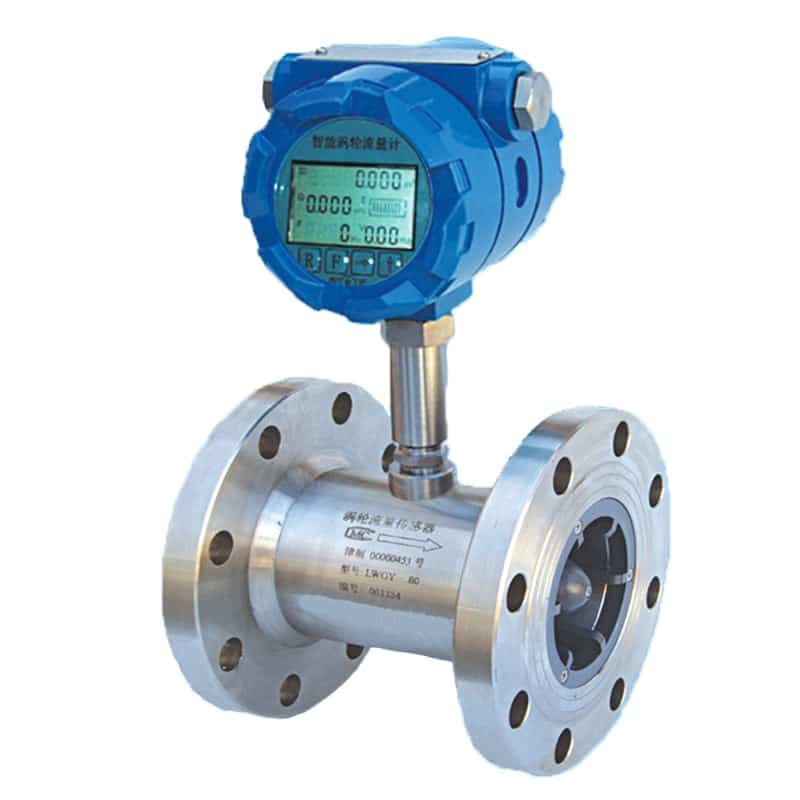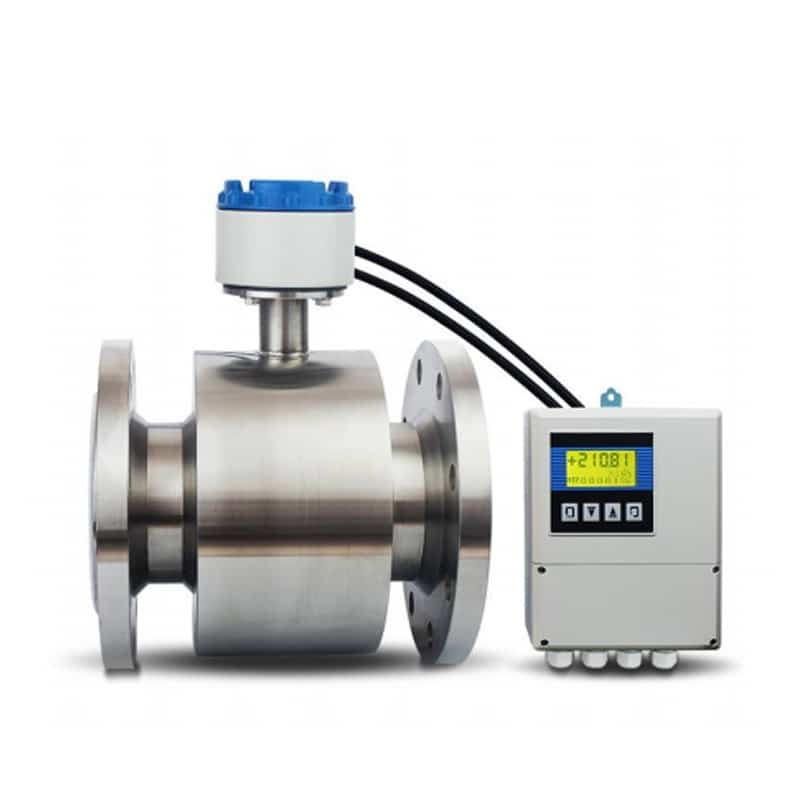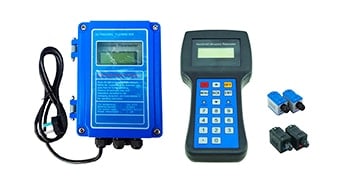In modern industrial processes, accurately measuring the flow of liquids and gases is crucial for ensuring production efficiency and safety. Non-intrusive ultrasonic flow meters, as advanced measuring instruments, are becoming the preferred choice across various industries due to their non-contact nature with the fluid medium, easy installation, and low maintenance costs.
What’s A Non-intrusive Ultrasonic Flow Meter?
Non-intrusive ultrasonic flowmeter is a kind of instrument that uses ultrasonic technology to measure the flow of liquid or gas. Unlike the traditional intrusive flowmeter, non-intrusive flowmeter does not require direct contact with the measured medium, thus avoiding any interference and contamination of the pipeline or fluid.
Advantages
- Non-intrusive: Does not require pipeline destruction, avoiding the risk of medium leakage and contamination.
- Easy installation: Can be installed and maintained without interrupting the flow.
- Wide applicability: Suitable for pipelines of various materials and sizes, especially those that are not suitable for traditional flow meters.
- Low maintenance cost: Due to the absence of moving parts and direct contact, the risk of wear and damage from the measured medium is low.
Working Principle
Transit Time Method
- The flow meter has two ultrasonic sensors, installed on the outer wall of the pipeline.
- The distance between the sensors and the transit time of the ultrasonic waves are used to calculate the fluid’s flow velocity.
- When the fluid flows, the transit time of the ultrasonic wave in the downstream direction shortens, while the transit time in the upstream direction lengthens. By comparing these two transit times, the fluid’s flow velocity can be calculated, thus determining the flow rate.
Doppler Method
- The flow meter emits ultrasonic waves and receives the ultrasonic signals reflected back from suspended particles or gas bubbles in the fluid.
- When the fluid flows, the frequency of the reflected ultrasonic waves changes (Doppler effect).
- By measuring the frequency change, the fluid’s flow velocity can be calculated.
Application Industry
- Water treatment and water supply systems
- Oil and gas industry
- Chemical and pharmaceutical industries
- HVAC systems
Difference From Traditional Flow Meter
Differences from Traditional Flow Meters:
Installation process:
- Non-intrusive ultrasonic flow meter: Can be installed without interrupting the flow or cutting the pipeline, avoiding any medium leakage or contamination.
- Traditional flow meter: Often requires cutting the pipeline and interrupting the flow, which can cause potential leakage and contamination risks.
Maintenance:
- Non-intrusive ultrasonic flow meter: Has no moving parts and does not come into direct contact with the fluid, resulting in lower wear and tear, and consequently lower maintenance costs.
- Traditional flow meter: Typically has moving parts that come into contact with the fluid, which can wear out over time and require more frequent maintenance.
Applicability:
- Non-intrusive ultrasonic flow meter: Suitable for a wide range of pipe materials and sizes, especially those not compatible with traditional flow meters.
- Traditional flow meter: Often limited by the type and size of the pipes it can be installed on, with some materials and sizes being incompatible.
Measurement method:
- Non-intrusive ultrasonic flow meter: Uses advanced methods such as the Transit Time Method or Doppler Method, which involve measuring the time or frequency of ultrasonic waves to determine flow rate.
- Traditional flow meter: Typically relies on mechanical methods, such as turbine or positive displacement, which measure the flow rate by direct contact with the fluid.
Impact on fluid flow:
- Non-intrusive ultrasonic flow meter: Does not obstruct the flow of fluid, ensuring no pressure drop or flow disturbance.
- Traditional flow meter: Can introduce a pressure drop or disturb the flow due to its intrusive nature.
These differences highlight the advantages of non-intrusive ultrasonic flow meters in terms of installation convenience, maintenance efficiency, broad applicability, and minimal impact on fluid flow.
Comparison of Flow Measurement Technologies
Differential Pressure Flow Meter
- Principle: Based on Bernoulli’s principle, it creates a pressure difference in the pipeline by installing a throttling device (such as an orifice plate, Venturi tube, or nozzle) to calculate the flow rate.
- Advantages: Mature technology, widely used; suitable for high-temperature and high-pressure environments.
- Disadvantages: Requires pressure sensors, complex installation; significant pressure loss; high maintenance cost.
Turbine Flow Meter
- Principle: Fluid drives the turbine to rotate as it flows through, and the rotation speed is proportional to the flow rate. Magnetic induction or photoelectric sensors measure the turbine’s speed to calculate the flow rate.
- Advantages: High measurement accuracy, quick response; suitable for clean liquids and gases.
- Disadvantages: Mechanical parts are prone to wear and require frequent maintenance; high requirements for fluid cleanliness.

Electromagnetic Flow Meter

- Principle: Based on Faraday’s law of electromagnetic induction, it generates an induced voltage as the fluid passes through a magnetic field. The voltage is proportional to the flow rate, and the flow rate is calculated by measuring the voltage.
- Advantages: No mechanical parts, suitable for corrosive fluids and wastewater; high accuracy, wide measurement range.
- Disadvantages: Can only be used for conductive fluids; relatively high cost.
Ultrasonic Flow Meter
- Principle: Uses the propagation characteristics of ultrasonic waves in the fluid for measurement, mainly including the Transit Time Method and Doppler Method.
- Advantages: Non-intrusive, no mechanical parts; suitable for various fluids, easy installation, and maintenance.
- Disadvantages: High requirements for fluid characteristics (e.g., particles, bubbles); measurement accuracy is greatly affected by the environment.

Factors to Consider When Choosing
Fluid type and characteristics
Homogeneity: Ensure the fluid is homogeneous for accurate measurement. High levels of particles, bubbles, or varying composition can affect accuracy.
Conductivity: While ultrasonic meters are generally suitable for non-conductive fluids, ensure the fluid’s characteristics align with the meter’s capabilities.
Pipe material and size
- Compatibility: Confirm the meter can be installed on the existing pipe material, whether metal, plastic, or others.
- Diameter: Ensure the meter is compatible with the pipe diameter. Most ultrasonic meters have specific size ranges.
Installation environment
- Accessibility: Ensure there is enough space and accessibility to install the sensors on the pipeline’s outer wall.
- Temperature and pressure: Check that the meter operates effectively within the environmental temperature and pressure ranges.
Flow rate range
- Measurement range: Confirm the meter can accurately measure the expected flow rate range of the application. Different models have varying optimal ranges.
Accuracy requirements
- Precision: Determine the required measurement accuracy for the application. Critical processes may need higher precision.
- Repeatability: Ensure the meter provides consistent results under similar conditions.
Maintenance and calibration
- Ease of maintenance: Consider maintenance requirements and the convenience of periodic checks or calibration.
- Calibration frequency: Understand the recommended calibration frequency and procedures to maintain long-term accuracy.
Summary
Non-intrusive ultrasonic flow meters have shown great potential in various industrial applications due to their high accuracy, low maintenance, and easy installation. As technology continues to advance and improve, this measurement tool will be widely used in more fields, further improving the efficiency and reliability of industrial processes.
Apure products are highly accurate and reliable and able to meet the needs of various complex application scenarios. By introducing advanced sensing technology and intelligent solutions, we provide customers with more comprehensive and accurate monitoring services. In addition to flow meters, apure also provides water quality monitoring sensors, level measurement, pressure measurement, temperature measurement and ozone sensors, choose us to provide you with quality solutions.
